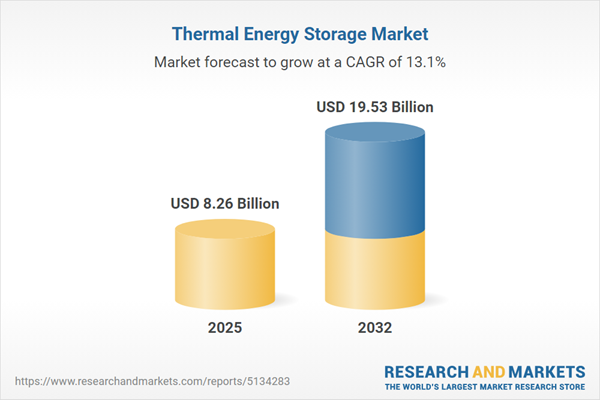Speak directly to the analyst to clarify any post sales queries you may have.
The thermal energy storage market is transforming executive strategies around grid resilience, decarbonization, and energy optimization. By enabling broad integration of renewables and enhancing operational flexibility, this sector has become central to sustainable energy leadership and efficiency targets.
Market Snapshot: Thermal Energy Storage Market Growth and Momentum
Global demand for thermal energy storage is rising as organizations seek smarter solutions for power generation, heating, and industrial cooling. The market expanded from USD 7.30 billion in 2024 to USD 8.26 billion in 2025, advancing at a compound annual growth rate (CAGR) of 13.08% and forecast to reach USD 19.53 billion by 2032. This surge is driven by robust investments and policy support, positioning thermal energy storage as an enabler for greater energy efficiency, grid reliability, and optimal use of renewable resources. Companies are adopting these solutions to better balance supply and demand, manage peak loads, and unlock opportunities within existing infrastructure.
Scope & Segmentation: Mapping Diverse Thermal Storage Solutions
This analysis provides a granular view of the market’s evolving landscape, helping stakeholders align strategies with opportunity hotspots and maximize ROI. The comprehensive segmentation ensures actionable insights into both current dynamics and future developments:
- Technology Types: Explores Latent Heat (with eutectic, inorganic, and organic systems), Sensible Heat (including concrete, molten salt, and water-based configurations), and Thermochemical solutions (chemical reactions and sorption processes), each suited for different operational profiles.
- Energy Source: Identifies storage solutions drawing from electricity sources (grid or renewables), solar thermal systems (including concentrated solar power and PV), and industrial waste heat recovery, providing flexibility for a range of operational settings.
- Applications: Highlights adoption across Commercial (HVAC and refrigeration), Industrial (process heating, power generation, waste heat recovery), Residential (domestic hot water, climate control), and Utility segments (grid support, peak shaving), showing sector-wide relevance.
- Storage Duration: Differentiates long, medium, and short-term storage systems, helping leaders match technology selection to project needs and risk profiles.
- End Use Industry: Covers heating and cooling, industrial processes, power generation, and refrigeration, reflecting the broad applicability and impact on multiple industries.
- Regions: Evaluates regional dynamics, encompassing the Americas (United States, Canada, Mexico, Brazil, Argentina, Chile, Colombia, Peru), Europe, Middle East and Africa (notably the United Kingdom, Germany, France, United Arab Emirates, Saudi Arabia, South Africa), and Asia-Pacific (China, India, Japan, Australia, South Korea, Southeast Asia), supporting locally tailored strategies.
- Leading Companies: Tracks key vendors including Trane Technologies Company, Johnson Controls International plc, Siemens Aktiengesellschaft, ABB Ltd, Ice Energy, EnergyNest AS, Abengoa, Acciona, BrightSource Energy, and SolarReserve LLC, providing insight into supplier strengths and innovations.
Segment-level awareness improves competitive positioning and aids decision-making on regional investments, technology adoption, and end-use market focus.
Key Takeaways: Strategic Insights for Senior Decision-Makers
- Thermal energy storage bridges variability between intermittent energy supply and changing demand, enhancing agility for utilities and industrial enterprises.
- Innovations in phase change materials, advanced sorption, and digital controls are enabling tailored storage durations and supporting evolving operational requirements.
- Integrated thermal systems facilitate efficiency improvements by servicing power generation, heating, and industrial processes within a single infrastructure.
- Regional disparities in policy focus and resource availability influence both technology deployment and adoption pace, requiring region-specific strategies.
- Collaborations between technology suppliers, system integrators, and end-user organizations are fostering resilience, operational flexibility, and scalable storage rollouts.
- With competition intensifying, industry frontrunners are prioritizing modular storage designs and digital integration to accelerate project delivery and differentiate offerings.
Tariff Impact: Navigating Policy and Supply Chain Adjustments
Recent tariffs in the United States affecting core components are prompting changes in procurement and vendor selection. Developers increasingly engage local suppliers and investigate global sourcing alternatives, leading to revisions in supplier contracts and the advancement of localized manufacturing strategies. This evolving policy context is driving greater focus on cost controls, risk management, and collaborative approaches to reinforce supply chain resilience across projects.
Methodology & Data Sources
The research utilizes a multi-tiered approach—primary interviews with technology developers, integrators, end-users, and regulators, alongside thorough secondary analysis of journals, patent data, market disclosures, and policies. Scenario modeling and segmentation matrices underpin the analytics, clarifying technology trends and risk exposure areas for stakeholders.
Why This Report Matters
- Empowers senior executives to align technology and operational investments with regulatory changes and the latest innovations in thermal energy storage.
- Provides actionable direction for supply chain strategies and partnership development, supporting resilience and responsiveness to dynamic market conditions.
- Facilitates the capture of emerging market opportunities while strengthening competitive positioning and business continuity.
Conclusion
Thermal energy storage is emerging as a critical element in advancing reliable, resilient, and sustainable energy systems. This report delivers the strategic intelligence needed for informed, future-ready decisions in a rapidly evolving industry landscape.
Additional Product Information:
- Purchase of this report includes 1 year online access with quarterly updates.
- This report can be updated on request. Please contact our Customer Experience team using the Ask a Question widget on our website.
Table of Contents
3. Executive Summary
4. Market Overview
7. Cumulative Impact of Artificial Intelligence 2025
List of Figures
Samples

LOADING...
Companies Mentioned
The key companies profiled in this Thermal Energy Storage market report include:- Trane Technologies Company
- Johnson Controls International plc
- Siemens Aktiengesellschaft
- ABB Ltd
- Ice Energy, Inc.
- EnergyNest AS
- Abengoa, S.A.
- Acciona, S.A.
- BrightSource Energy, Inc.
- SolarReserve LLC
Table Information
| Report Attribute | Details |
|---|---|
| No. of Pages | 185 |
| Published | October 2025 |
| Forecast Period | 2025 - 2032 |
| Estimated Market Value ( USD | $ 8.26 Billion |
| Forecasted Market Value ( USD | $ 19.53 Billion |
| Compound Annual Growth Rate | 13.0% |
| Regions Covered | Global |
| No. of Companies Mentioned | 11 |









